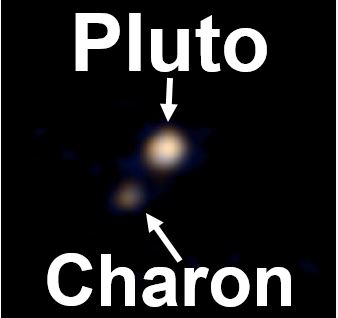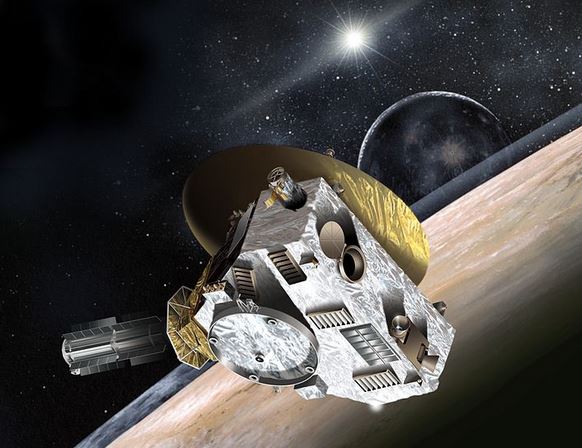In what can be seen as a reddish world, the first colour image ever of the dwarf planet Pluto has been taken by the New Horizons probe, which is set to do a flyby on 14 July. NASA released the picture on Wednesday, which also showed its largest moon, Charon.
Pluto, about one-sixth the mass of our Moon and one-third its volume, is the largest object in the Kuiper belt (a region of our Solar System beyond the planets). It is the tenth-most-massive known body directly orbiting the Sun.
New Horizons is a NASA space probe launched on 19th January, 2006, to study Pluto, its moons and one or two other Kuiper belt objects. Travelling at a speed of 58,536 km/h (36,373 mph), it set the record for the highest launch speed of any man-made object from Earth.

Image of Pluto and its largest moon, Charon, taken by the Ralph color imager aboard New Horizons on April 9, 2015, from a distance of about 71 million miles. (Image: NASA)
When it flies by Pluto it will acquire a mass of data and will then return to Earth over the course of the next 16 months.
Messages take several hours to get here
New Horizons is currently five billion kilometres from Earth, which means that when it sends a radio signal it takes 4.6 hours to get here.
When the encounter with Pluto does occur, it will be a historical event, marking the completion of all “classical nine” planets in our Solar System being visited by a human-made space probe.
It will cap a five-decade-long era of reconnaissance that started with Venus and Mars in the early 1960s, and continued through the first peeks at Mercury, Jupiter and Saturn in the 1970s, and Neptune and Uranus in the 1980s.
Exciting images will come from May onwards
To date, the clearest pictures taken of Pluto have come from the Hubble Space Telescope, which reveal just a blob. From May, as New Horizons gets really close, we should get significantly better pictures.
Today’s release is just to whet our appetite, NASA said. The photograph was captured by the probe’s Ralph colour imager on 9th April, at a distance of 115 million km from the dwarf planet, which is approximately the same as from the Sun to Venus.
John Grunsfeld, astronaut, and associate administrator of the NASA Science Mission Directorate at the agency’s Headquarters in Washington, said:
“Scientific literature is filled with papers on the characteristics of Pluto and its moons from ground based and Earth orbiting space observations, but we’ve never studied Pluto up close and personal.”
“In an unprecedented flyby this July, our knowledge of what the Pluto systems is really like will expand exponentially and I have no doubt there will be exciting discoveries.”
Alan Stern, New Horizons principal investigator from Southwest Research Institute (SwRI) in Boulder, Colorado, said:
“This is pure exploration; we’re going to turn points of light into a planet and a system of moons before your eyes! New Horizons is flying to Pluto – the biggest, brightest and most complex of the dwarf planets in the Kuiper Belt.”
“This 21st century encounter is going to be an exploration bonanza unparalleled in anticipation since the storied missions of Voyager in the 1980s.”

An artist’s concept of the New Horizons spacecraft during its planned encounter with Pluto and its moon, Charon. (Image: Wikipedia)
Pluto has interesting features
Pluto, the largest body we know of in the Kuiper Belt, has a nitrogen-filled atmosphere, complex seasons, distinct surface markings, an interior made of ice-rock that might harbor an ocean, and at least five moons.
Its largest moon – Charon – may itself have an interior ocean and/or an atmosphere.
Leslie Young, deputy project scientist at SwRI, said:
“There’s no doubt, Charon is a rising star in terms of scientific interest, and we can’t wait to reveal it in detail in July.”
When the New Horizons project was first thought of in 2001, the aim was just to visit Pluto and Charon, because nobody knew about the other four smaller moons.
NASA wrote:
“The spacecraft’s suite of seven science instruments – which includes cameras, spectrometers, and plasma and dust detectors – will map the geology of Pluto and Charon and map their surface compositions and temperatures; examine Pluto’s atmosphere, and search for an atmosphere around Charon; study Pluto’s smaller satellites; and look for rings and additional satellites around Pluto.”
New Horizons will eventually be 12,500 kilometres (7,750 miles) from Pluto’s surface. Getting to that point is critical for the mission.
Alice Bowman, New Horizons mission operations manager at the Johns Hopkins University Applied Physics Laboratory (APL) in Laurel, Maryland, which built and operates the probe, said:
“Our team has worked hard to get to this point, and we know we have just one shot to make this work. We’ve plotted out each step of the Pluto encounter, practiced it over and over, and we’re excited the ‘real deal’ is finally here.”
Video – First colour photo of Pluto
